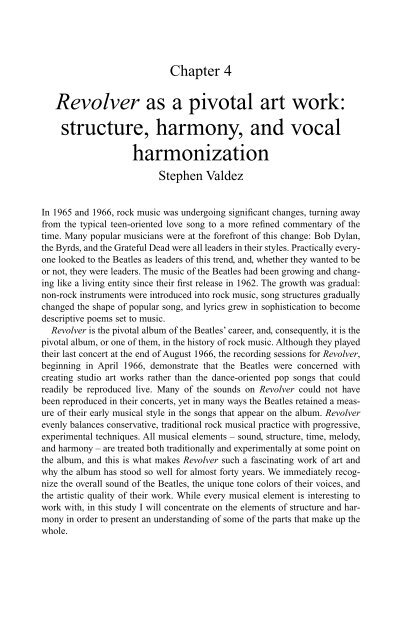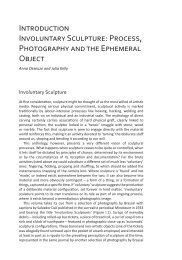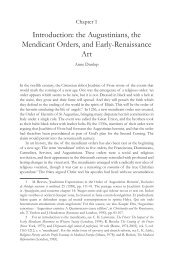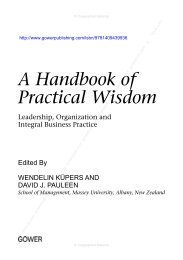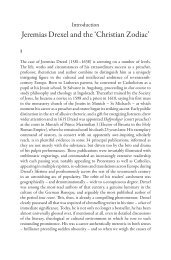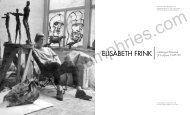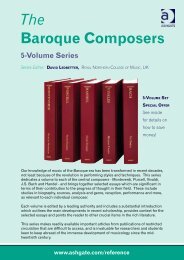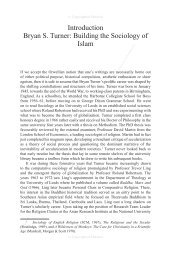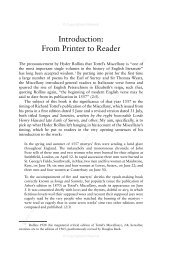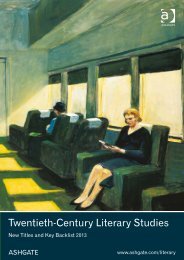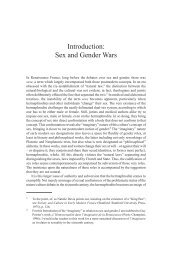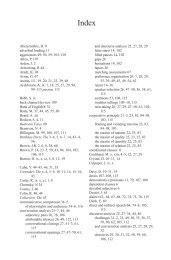Revolver as a pivotal art work: structure, harmony, and ... - Ashgate
Revolver as a pivotal art work: structure, harmony, and ... - Ashgate
Revolver as a pivotal art work: structure, harmony, and ... - Ashgate
Create successful ePaper yourself
Turn your PDF publications into a flip-book with our unique Google optimized e-Paper software.
Chapter 4<br />
<strong>Revolver</strong> <strong>as</strong> a <strong>pivotal</strong> <strong>art</strong> <strong>work</strong>:<br />
<strong>structure</strong>, <strong>harmony</strong>, <strong>and</strong> vocal<br />
harmonization<br />
Stephen Valdez<br />
In 1965 <strong>and</strong> 1966, rock music w<strong>as</strong> undergoing significant changes, turning away<br />
from the typical teen-oriented love song to a more refined commentary of the<br />
time. Many popular musicians were at the forefront of this change: Bob Dylan,<br />
the Byrds, <strong>and</strong> the Grateful Dead were all leaders in their styles. Practically everyone<br />
looked to the Beatles <strong>as</strong> leaders of this trend, <strong>and</strong>, whether they wanted to be<br />
or not, they were leaders. The music of the Beatles had been growing <strong>and</strong> changing<br />
like a living entity since their first rele<strong>as</strong>e in 1962. The growth w<strong>as</strong> gradual:<br />
non-rock instruments were introduced into rock music, song <strong>structure</strong>s gradually<br />
changed the shape of popular song, <strong>and</strong> lyrics grew in sophistication to become<br />
descriptive poems set to music.<br />
<strong>Revolver</strong> is the <strong>pivotal</strong> album of the Beatles’ career, <strong>and</strong>, consequently, it is the<br />
<strong>pivotal</strong> album, or one of them, in the history of rock music. Although they played<br />
their l<strong>as</strong>t concert at the end of August 1966, the recording sessions for <strong>Revolver</strong>,<br />
beginning in April 1966, demonstrate that the Beatles were concerned with<br />
creating studio <strong>art</strong> <strong>work</strong>s rather than the dance-oriented pop songs that could<br />
readily be reproduced live. Many of the sounds on <strong>Revolver</strong> could not have<br />
been reproduced in their concerts, yet in many ways the Beatles retained a me<strong>as</strong>ure<br />
of their early musical style in the songs that appear on the album. <strong>Revolver</strong><br />
evenly balances conservative, traditional rock musical practice with progressive,<br />
experimental techniques. All musical elements – sound, <strong>structure</strong>, time, melody,<br />
<strong>and</strong> <strong>harmony</strong> – are treated both traditionally <strong>and</strong> experimentally at some point on<br />
the album, <strong>and</strong> this is what makes <strong>Revolver</strong> such a f<strong>as</strong>cinating <strong>work</strong> of <strong>art</strong> <strong>and</strong><br />
why the album h<strong>as</strong> stood so well for almost forty years. We immediately recognize<br />
the overall sound of the Beatles, the unique tone colors of their voices, <strong>and</strong><br />
the <strong>art</strong>istic quality of their <strong>work</strong>. While every musical element is interesting to<br />
<strong>work</strong> with, in this study I will concentrate on the elements of <strong>structure</strong> <strong>and</strong> <strong>harmony</strong><br />
in order to present an underst<strong>and</strong>ing of some of the p<strong>art</strong>s that make up the<br />
whole.
90 EVERY SOUND THERE IS<br />
Structure<br />
All of the songs on <strong>Revolver</strong> are either strophic song forms, with alternating verses<br />
<strong>and</strong> choruses, or st<strong>and</strong>ard (AABA) song forms, consisting of a verse (A) <strong>and</strong><br />
contr<strong>as</strong>ting bridge (B). The strophic form is common to folk music styles, including<br />
the blues that is the primary b<strong>as</strong>is of rock music. Of course, st<strong>and</strong>ard song<br />
form, a more contrived song <strong>structure</strong> common in American popular music (p<strong>art</strong>icularly<br />
ballads), also influenced the development of rock. The legacy of st<strong>and</strong>ard<br />
song form – especially the compositions of popular songwriters like George<br />
Gershwin, Jerome Kern, Cole Porter, among others – generally dictates a balanced<br />
<strong>structure</strong> in which the length of the A section is equal to the length of the<br />
B section. This frequently resulted, during the ‘golden age of American popular<br />
song’ (roughly 1925 through 1950), in a song <strong>structure</strong> in which each section consisted<br />
of eight me<strong>as</strong>ures, yielding a thirty-two-me<strong>as</strong>ure form. 1<br />
Examples of strophic song form on <strong>Revolver</strong> are ‘Eleanor Rigby’, ‘Love You<br />
To’, ‘Yellow Submarine’, ‘Good Day Sunshine’, ‘For No One’, ‘Got To Get You<br />
Into My Life’ <strong>and</strong> ‘Tomorrow Never Knows’. Of these, the songs ‘Love You To’,<br />
‘Yellow Submarine’ <strong>and</strong> ‘Good Day Sunshine’ alternate verses with a recurring<br />
chorus, although the l<strong>as</strong>t song begins with the chorus while the first two both<br />
begin with the verse; ‘Tomorrow Never Knows’ consists of a series of verses with<br />
no recurring choruses. These three songs represent the traditional <strong>as</strong>pect of<br />
strophic form on the album.<br />
The other three strophic songs incorporate <strong>as</strong>pects of experimentation. ‘Eleanor<br />
Rigby’ begins with an introduction that recurs <strong>as</strong> an interlude between the second<br />
chorus <strong>and</strong> the third verse, <strong>and</strong> then appears again <strong>as</strong> a countermelody against the<br />
final chorus. McC<strong>art</strong>ney’s ‘For No One’ presents the strophic song form in another<br />
experimental way. Upon the return of the verse after the first chorus, symphonic<br />
hornist Alan Civil performs a solo, which later turns out to be a countermelody<br />
to the final verse. The chorus is repeated followed by two statements of the verse<br />
<strong>and</strong> a final presentation of the chorus ends the song. The <strong>harmony</strong> at the end of the<br />
chorus is constructed <strong>as</strong> a turnaround, that is, it harmonically sets up a return of<br />
the verse progression. However, with the song ending on the turnaround, we are<br />
presented with a feeling of unfinished business not only harmonically but structurally<br />
<strong>as</strong> well. The unfinished character of the <strong>harmony</strong> <strong>and</strong> the <strong>structure</strong> leaves<br />
the listener expecting more. Harmonically, the 4-3 suspension F-sharp chord<br />
dem<strong>and</strong>s a resolution to the tonic chord, but the <strong>harmony</strong> is left unresolved. The<br />
open-ended feeling of the bridge suggests a return of the verse, which harmonically<br />
closes on the tonic, but the song denies us this closure <strong>as</strong> well. These musical<br />
representations of non-resolution heighten the underst<strong>and</strong>ing of McC<strong>art</strong>ney’s<br />
lyrics: the music tells us that there are unresolved matters in the relationship, at<br />
le<strong>as</strong>t in the narrator’s point of view.<br />
‘Got To Get You Into My Life’ presents a strophic <strong>structure</strong> <strong>and</strong> recurring<br />
refrain cleverly constructed so <strong>as</strong> to blur the distinction between strophic <strong>and</strong>
REVOLVER AS A PIVOTAL ART WORK 91<br />
st<strong>and</strong>ard forms. Sixteen me<strong>as</strong>ures long, the verse consists of two eight-me<strong>as</strong>ure<br />
periods. The first period alternates the tonic G chord with the subtonic F chord;<br />
to the ear, this <strong>harmony</strong> is clearly unfinished, ending <strong>as</strong> it does on the weak<br />
subtonic, so it cannot be considered a complete verse. The second period begins<br />
on the mediant B minor chord supported by a b<strong>as</strong>s line that descends chromatically<br />
from B to A-flat. This phr<strong>as</strong>e is repeated, followed by a third phr<strong>as</strong>e that harmonically<br />
closes the verse with a subdominant gesture (C, E minor7, <strong>and</strong> A<br />
minor7) to the dominant (D7) to tonic (G) cadence. At this point the listener h<strong>as</strong><br />
a feeling of closure; the verse is complete.<br />
The verse is repeated but this time leads to the refrain. Six me<strong>as</strong>ures long, the<br />
refrain consists of the title phr<strong>as</strong>e sung <strong>as</strong> a hook for two me<strong>as</strong>ures followed by<br />
an instrumental fill played by the horn <strong>and</strong> rhythm sections. The brevity of the<br />
refrain creates a striking imbalance against the sixteen-me<strong>as</strong>ure verse. Too short<br />
to be considered a chorus, it is also too short to be considered a bridge. Yet the<br />
way in which McC<strong>art</strong>ney uses the refrain implies the AABA <strong>structure</strong> of st<strong>and</strong>ard<br />
song form: verse one, verse two, refrain, verse 3, refrain, refrain, coda. This <strong>structure</strong><br />
of the song, in conjunction with the harmonic progression, shows a strophic<br />
form, but the clever application of the refrain causes one to wonder whether it is<br />
a st<strong>and</strong>ard song form – the distinction is effectively blurred.<br />
The other seven songs on the album are examples of st<strong>and</strong>ard song form. The<br />
songs that exhibit conservative or traditional traits of st<strong>and</strong>ard song form are ‘Here,<br />
There, <strong>and</strong> Everywhere’, ‘She Said She Said’, ‘And Your Bird Can Sing’ <strong>and</strong> ‘I<br />
Want To Tell You’. However, even in these songs we encounter various degrees of<br />
imbalance: ‘She Said She Said’ features ten-me<strong>as</strong>ure verses against an elevenme<strong>as</strong>ure<br />
bridge, ‘I Want To Tell You’ h<strong>as</strong> eleven-me<strong>as</strong>ure verses countered by an<br />
eight-me<strong>as</strong>ure bridge, <strong>and</strong> ‘Here, There, <strong>and</strong> Everywhere’ presents eight-me<strong>as</strong>ure<br />
verses with a four-me<strong>as</strong>ure bridge. Only ‘And Your Bird Can Sing’ follows the traditional<br />
st<strong>and</strong>ard song <strong>structure</strong> of thirty-two me<strong>as</strong>ures, with verse <strong>and</strong> bridge sections<br />
balanced at eight me<strong>as</strong>ures each. This <strong>as</strong>ymmetry of sections is of course not<br />
new to the Beatles or to popular music; there are many previous examples, both by<br />
the Beatles <strong>and</strong> their predecessors, in which the bridge is shorter or longer than the<br />
verse. My point is that these songs, imbalanced <strong>as</strong> they are, still represent the more<br />
traditional <strong>as</strong>pects of st<strong>and</strong>ard song form on <strong>Revolver</strong>. Other songs on the album are<br />
more radically imbalanced between sections, for instance ‘Doctor Robert’ in which<br />
eighteen-me<strong>as</strong>ure verses are countered by a ten-me<strong>as</strong>ure bridge.<br />
The most progressive examples of song form on <strong>Revolver</strong> occur in the songs<br />
‘Taxman’ <strong>and</strong> ‘I’m Only Sleeping’. Hybrids of both strophic <strong>and</strong> st<strong>and</strong>ard forms,<br />
these songs have the clearly defined verses <strong>and</strong> choruses of the strophic, yet they<br />
also have the bridge sections characteristic of st<strong>and</strong>ard form. Both songs are represented<br />
in the form:<br />
[verse/chorus] [verse/chorus] bridge [verse/chorus]<br />
A A B A
92 EVERY SOUND THERE IS<br />
so that, if the verse <strong>and</strong> chorus are considered together <strong>as</strong> a unit, the form resembles<br />
the AABA <strong>structure</strong> of st<strong>and</strong>ard song form. Yet, because of the clear delineation<br />
between the verse <strong>and</strong> the chorus, the songs dep<strong>art</strong> from the traditional<br />
st<strong>and</strong>ard song form.<br />
Hybrid strophic/st<strong>and</strong>ard song forms were not the norm in the mid-1960s,<br />
although the Beatles <strong>and</strong> others had certainly experimented with them earlier.<br />
Already in their debut album Ple<strong>as</strong>e Ple<strong>as</strong>e Me (1963), the song ‘I Saw Her<br />
St<strong>and</strong>ing There’ is a st<strong>and</strong>ard song form in which the verse section presents a<br />
recurring chorus-like segment that contains the hook of the song <strong>and</strong> sounds<br />
essentially like a chorus, though it is not a chorus. After <strong>Revolver</strong>, hybrid strophic/st<strong>and</strong>ard<br />
song forms appear more frequently in the Beatles’ corpus, for example<br />
‘With a Little Help From My Friends’ on Sgt Pepper (1967). By the 1970s,<br />
most rock groups had adopted this <strong>structure</strong>, <strong>and</strong> today practically every rock <strong>and</strong><br />
pop song on commercial radio <strong>and</strong> recordings take this form.<br />
Many songs in st<strong>and</strong>ard form repeat both the bridge <strong>and</strong> the final verse, resulting<br />
in an overall form of AABABA. This brief repetition is present in most of the<br />
st<strong>and</strong>ard songs on <strong>Revolver</strong>. Again the Beatles take some liberties with this b<strong>as</strong>ic<br />
format: Harrison, in ‘Taxman’, presents the bridge only once in the song but<br />
repeats the verse <strong>and</strong> chorus segments twice after the bridge, resulting in an overall<br />
form of AABAA. In ‘Doctor Robert’, Lennon repeats the bridge <strong>and</strong> goes<br />
immediately into the coda of the song, creating an overall form of AABAB<br />
(coda). However, since the coda is derived from the guitar riff <strong>and</strong> lyrics of the<br />
first p<strong>art</strong> of the verse, it sounds <strong>as</strong> if the form of the song follows the conventional<br />
AABABA <strong>structure</strong>; not until the coda begins to fade do we realize that the song<br />
form proper ended with the bridge.<br />
The introductions <strong>and</strong>/or cod<strong>as</strong> of some songs also contribute to the successful<br />
presentation of <strong>structure</strong>. Most of the songs on <strong>Revolver</strong> feature a brief two- or<br />
four-me<strong>as</strong>ure introduction, for example ‘Taxman’ <strong>and</strong> ‘Doctor Robert’, in which<br />
the b<strong>as</strong>ic accompanimental riff sets the stage for the rest of the song. Many songs<br />
have a coda derived from either verse or chorus material. Some songs, like ‘For<br />
No One’, have neither introductions nor cod<strong>as</strong>. Others feature an innovative use<br />
of introductory material, such <strong>as</strong> ‘Eleanor Rigby’’s use of its introduction <strong>as</strong> both<br />
interlude <strong>and</strong> countermelody. One such interesting introduction appears in<br />
Harrison’s song ‘Love You To’.<br />
The unique ‘Love You To’ represents Harrison’s first real excursion into North<br />
Indian music. Having been introduced to the sound of the sitar by Byrd guitarist<br />
David Crosby, Harrison had first used the instrument in the accompaniment of<br />
‘Norwegian Wood’ on Rubber Soul (1965). However, the use of the sitar on<br />
‘Norwegian Wood’ w<strong>as</strong> more in the way of a western instrument, in that it w<strong>as</strong><br />
used to double Lennon’s vocal melody. With ‘Love You To’ Harrison makes a<br />
whole-he<strong>art</strong>ed attempt to reproduce the Indian style of music which he had been<br />
studying since June 1966 with Ravi Shankar (Everett, 1999, p. 40). He stated that<br />
‘[“Love You To”] w<strong>as</strong> the first song where I consciously tried to use the sitar <strong>and</strong>
REVOLVER AS A PIVOTAL ART WORK 93<br />
tabla on the b<strong>as</strong>ic track’ (Harrison, 1980, p. 102). This is the only song on<br />
<strong>Revolver</strong> in which none of the other three Beatles takes p<strong>art</strong>, either <strong>as</strong> vocalists or<br />
instrumentalists.<br />
B<strong>as</strong>ed on Indian practice, the introduction of ‘Love You To’begins with two upward<br />
strokes of the plectrum on the svaram<strong>and</strong>al, from high to low pitches. This is followed<br />
by a brief, free-metered section, called alap, in which the sitar outlines the raga, or<br />
mode, of the piece. This improvised melody gradually rises <strong>and</strong> falls in pitch <strong>and</strong><br />
incre<strong>as</strong>es the rhythmic intensity before ending on the tonic note, or sa in the Indian<br />
system. At this point the tabla enters to establish the tala, or rhythm, while a tamboura<br />
establishes the key by droning the sa <strong>and</strong> pa, the tonic <strong>and</strong> dominant pitches, of the<br />
raga. This introduction effectively sets up the Indian mood of the song.<br />
The creativity that the Beatles employ in regard to song <strong>structure</strong> demonstrates<br />
the <strong>pivotal</strong> nature of these songs, <strong>and</strong> thus the <strong>pivotal</strong> nature of <strong>Revolver</strong> <strong>as</strong> a<br />
whole. Most of the Beatles’ earlier songs remained true to traditional strophic <strong>and</strong><br />
st<strong>and</strong>ard forms. The structural experimentation on <strong>Revolver</strong> led to further experimentation<br />
on a larger scale, including the conceptual <strong>structure</strong>s of Sgt Pepper’s<br />
Lonely He<strong>art</strong>s Club B<strong>and</strong> <strong>and</strong> the second side of Abbey Road. Occurring contemporaneously<br />
with <strong>work</strong>s by Bob Dylan, Frank Zappa, Mick Jagger <strong>and</strong> Keith<br />
Richards, <strong>and</strong> Brian Wilson, the Beatles’ conceptions of <strong>structure</strong> changed forever<br />
from the simple strophic <strong>and</strong> st<strong>and</strong>ard pop formats to more original <strong>structure</strong>s<br />
defined by the design of the lyrics.<br />
Harmony<br />
Two <strong>as</strong>pects of <strong>harmony</strong> on <strong>Revolver</strong> should be considered: the overall chord progressions<br />
of the songs <strong>and</strong> the manner in which the lead <strong>and</strong> supporting vocals are<br />
harmonized above the chord progressions. As with structural concerns, the songs<br />
of <strong>Revolver</strong> provide examples of traditional <strong>and</strong> experimental <strong>harmony</strong>. Although<br />
the chord progressions are not thoroughly traditional, often employing seventh<br />
chords in non-dominant functions, many progressions function traditionally relative<br />
to the blues foundation of rock. This discussion explores the Beatles’ approach<br />
to <strong>harmony</strong>, illustrating both traditional <strong>and</strong> experimental <strong>as</strong>pects of <strong>harmony</strong>.<br />
Many songs on <strong>Revolver</strong> are written in b<strong>as</strong>ic diatonic <strong>harmony</strong>. Their cl<strong>as</strong>sic<br />
children’s song, ‘Yellow Submarine’, is a well-known example of the Beatles’<br />
more traditional harmonic writing. Everything about the song presents an idea of<br />
simplicity: the words are immediately intelligible, the rhythms e<strong>as</strong>y to sing, <strong>and</strong><br />
the melody, with its small range, e<strong>as</strong>y to remember. Perhaps the most traditional<br />
harmonic progression on the album, the diatonic progression of the verse in G<br />
major also depicts simplicity:<br />
I V7 IV I vi ii V<br />
G D C G E minor A minor D7
94 EVERY SOUND THERE IS<br />
The opening phr<strong>as</strong>e of the verse presents a traditional harmonic dep<strong>art</strong>ure from<br />
tonic to dominant (G to D7) immediately followed by a soft plagal return from<br />
subdominant to tonic (C to G) – two different traditional harmonic motions melded<br />
together in an opening gesture. The remaining half of the verse progression<br />
flows e<strong>as</strong>ily to the half cadence, the dominant D7 approached by the relative<br />
minor of the key (E minor) <strong>and</strong> the minor supertonic (A minor) – a very traditional<br />
progression leading to the chorus.<br />
In Harrison’s song ‘I Want To Tell You’, the harmonic progression of the verse<br />
is also traditional, a three-chord <strong>structure</strong> in A major:<br />
I V7/V V7 I<br />
A B7 E7 A<br />
However, <strong>as</strong> b<strong>as</strong>ic <strong>as</strong> the chord progression is in this song, the application of dissonances<br />
in the accompaniment brings out an experimental character of this song.<br />
The presence of the tritone F-natural/B in the piano p<strong>art</strong> on the E7 chord intentionally<br />
upsets the traditional <strong>as</strong>pect of the <strong>harmony</strong>:<br />
Figure 4.1<br />
‘I Want To Tell You’, verse 1, m. 6, accompaniment<br />
The harmonic progression of the bridge is interesting in that the chord progression<br />
is the result of a chromatically descending inner voice. The bridge progression<br />
remains essentially in A major, although the emph<strong>as</strong>is on B (major, minor,<br />
<strong>and</strong> diminished chords) presents a briefly contr<strong>as</strong>ting <strong>harmony</strong>, a common feature<br />
of the bridge:<br />
Figure 4.2<br />
‘I Want To Tell You’, bridge, mm. 1–4, <strong>harmony</strong><br />
While the fundamental <strong>harmony</strong> of ‘I Want To Tell You’ is traditional, the
chromatic motion of the inner lines, p<strong>art</strong>icularly in the bridge, moves the song<br />
closer to an experimental application of <strong>harmony</strong>.<br />
Another song by Harrison, the album opener ‘Taxman’, presents a relatively<br />
traditional approach to <strong>harmony</strong> <strong>as</strong> well. The song is b<strong>as</strong>ed on a repetitive guitar<br />
riff on a D7 chord; the <strong>harmony</strong> of the verse <strong>and</strong> refrain appears to be a simple<br />
progression in the D Mixolydian mode; however, the lowered third scale degree<br />
(F natural), used <strong>as</strong> the seventh of the subdominant G7 chord, acts <strong>as</strong> a blue cross<br />
relation with the F-sharp of the key:<br />
I7 VII IV7 I7<br />
D7 C G7 D7<br />
REVOLVER AS A PIVOTAL ART WORK 95<br />
The <strong>harmony</strong> of the bridge shifts between the tonic D7 <strong>and</strong> the subtonic C7, contributing<br />
to the modal, rather than tonal, harmonic tendencies of ‘Taxman’.<br />
Harmonies <strong>and</strong> melodies on <strong>Revolver</strong> frequently exploit modal tendencies.<br />
Modality can be said to have existed in rock music since its inception because of<br />
the strong influence of the blues on the music. Blues <strong>harmony</strong> <strong>and</strong> melody are<br />
modal rather than tonal through the use of the blue, or slightly lowered, third <strong>and</strong><br />
seventh scale degrees. Since the earliest rock ’n’ roll developed from the blues,<br />
<strong>and</strong> the Beatles were influenced by those early forms, it st<strong>and</strong>s to re<strong>as</strong>on that blues<br />
modality is present in their compositions. In addition, the folk music of Great<br />
Britain <strong>and</strong> the US with which the Beatles were also familiar (<strong>and</strong> by which they<br />
were influenced) is often modal <strong>as</strong> well. And, of course, their experimentation<br />
with Indian music led them to explore e<strong>as</strong>tern modalities. The Beatles had earlier<br />
used non-blues modality, for example in Lennon’s ‘Norwegian Wood’; in this<br />
song the verse is written in E Mixolydian while the bridge is written in E Dorian.<br />
They experimented with non-blues modality even further on <strong>Revolver</strong>.<br />
‘Tomorrow Never Knows’ is another such modal piece, not quite a western mode<br />
but not quite an e<strong>as</strong>tern mode either. The foundation of the song is a b<strong>as</strong>s guitar riff<br />
that emph<strong>as</strong>izes a pedal C with a brief, syncopated B-flat on the upbeat of beat three:<br />
Figure 4.3<br />
‘Tomorrow Never Knows’, introduction, m. 3, b<strong>as</strong>s riff<br />
The b<strong>as</strong>s riff is strongly supported by the drum rhythm. In addition to the C riff,<br />
the tamboura, the first instrument heard on the track, drones the pitch C throughout<br />
the piece <strong>and</strong> the organ fills in block chords on C7 <strong>and</strong> B-flat. ‘Tomorrow<br />
Never Knows’ is b<strong>as</strong>ed on the C mixolydian mode (a C major scale with a B-flat<br />
rather than a B natural) with the solo melody, sung by Lennon, outlining a C7<br />
chord (C-E-G-B-flat). Oddly, this same tonic to subtonic motion when used in
96 EVERY SOUND THERE IS<br />
‘Taxman’ is perceived <strong>as</strong> a western modality because of the vocal harmonization<br />
that <strong>work</strong>s with the chord progression. The lack of other pitches from the mode<br />
in ‘Tomorrow Never Knows’ emph<strong>as</strong>izes the mysterious quality of the sound,<br />
while the stark, almost chant-like melody is a perfect vehicle for the philosophically<br />
serious content of the lyrics.<br />
‘Eleanor Rigby’ also experiments with mode, though more of an English folklike<br />
approach to modality than an e<strong>as</strong>tern approach. The <strong>harmony</strong> of the song<br />
proper is essentially in E minor following the C major introduction; the chorus,<br />
while still b<strong>as</strong>ed on an E minor mode, features a chromatically descending inner<br />
p<strong>art</strong> played by the first viola, resulting in the chromatic <strong>harmony</strong> E minor-E<br />
minor7-C6-E minor. The melody of the verse fluctuates between E Dorian (with<br />
the use of C-sharp) <strong>and</strong> E aeolian (with a C natural). 2<br />
In Harrison’s song ‘Love You To’, the modal b<strong>as</strong>is of the raga is the Indian kafi<br />
that in C, which corresponds to the western C Dorian mode. Dorian melodies <strong>and</strong><br />
harmonies frequently occur in rock music, due in p<strong>art</strong> to the e<strong>as</strong>e in which the<br />
Dorian mode fits the h<strong>and</strong> <strong>and</strong> the guitar fretboard. Furthermore, the mode closely<br />
approximates the blues mode, with lowered third <strong>and</strong> lowered seventh scale<br />
degrees, but a natural sixth degree. At any rate, the harmonic <strong>and</strong> melodic <strong>structure</strong><br />
of ‘Love You To’ is clearly b<strong>as</strong>ed on Indian modal practice: the tamboura drones sa<br />
<strong>and</strong> pa (tonic <strong>and</strong> dominant notes of the mode), the tabla sets forth a sixteen-beat<br />
tala (rhythm), the introductory improvisation in the alap follows Indian melodic<br />
practice, <strong>and</strong> <strong>as</strong> Harrison stated, he w<strong>as</strong> trying to express himself in Hindu terms.<br />
This is a new turn for the Beatles <strong>and</strong> for rock music in general; the culmination of<br />
Hindu-b<strong>as</strong>ed rock appears in the so-called ‘raga rock’ of the late 1960s.<br />
Practitioners of raga rock, besides the Beatles, include the Byrds, the Rolling<br />
Stones, the Buffalo Springfield, the Paul Butterfield Blues B<strong>and</strong>, <strong>and</strong> the Yardbirds. 3<br />
In McC<strong>art</strong>ney’s ‘Good Day Sunshine’ we have a song that clearly straddles the<br />
Beatles’ old <strong>and</strong> new styles. The <strong>harmony</strong>, which on a local level makes tonal<br />
sense, is ambiguous when seen in the light of the actual key in which the song w<strong>as</strong><br />
written. The chorus clearly tonicizes B major:<br />
I V IV<br />
B F-sharp E<br />
However, the verse is written in A major <strong>and</strong> follows the progression A-F-sharp7-<br />
B7-E7, incorporating a secondary dominant of the secondary dominant <strong>as</strong> a subdominant<br />
substitution:<br />
I V7/V7/V7 V7/V V7<br />
A F-sharp7 B7 E7<br />
This results in a progression that is tonally ambiguous: it is unclear if the <strong>harmony</strong><br />
is in A major or B major.
REVOLVER AS A PIVOTAL ART WORK 97<br />
‘Doctor Robert’ features another variety of ambiguous <strong>harmony</strong>. On the surface,<br />
the song seems to be traditional, but hidden eccentricities demonstrate how experimental<br />
the Beatles were becoming. The <strong>harmony</strong> of ‘Doctor Robert’ is in A major<br />
<strong>and</strong> stresses the tonic with a flattened seventh from the country-like introduction<br />
through the first nine me<strong>as</strong>ures of the verse. The l<strong>as</strong>t half of the verse tonicizes the<br />
supertonic B with the use of major submediant (F-sharp7) <strong>as</strong> a secondary dominant.<br />
The further stress on B major in the bridge, which shifts from B major to E major<br />
over a pedal B in the b<strong>as</strong>s <strong>and</strong> guitar p<strong>art</strong>s, also seems to point to a tonic on B major.<br />
However, suddenly the <strong>harmony</strong> shifts to an A7 chord <strong>as</strong> the introductory riff reappears<br />
to bring about a return to the verse. The harmonic ambiguity of ‘Doctor<br />
Robert’ h<strong>as</strong> been suggested to be an aural depiction of mind expansion; the<br />
song is notoriously known <strong>as</strong> one of Lennon’s drug songs with various explanations<br />
for its origins given. As Walter Everett points out, ‘such irregular tonal contr<strong>as</strong>ts<br />
will be exercised more often in the psychedelic songs of 1967’ (Everett, 1999,<br />
p. 46).<br />
One of the most experimental endeavors on <strong>Revolver</strong> is Lennon’s ‘I’m Only<br />
Sleeping’. The recording quality evokes the hazy, sleep-like quality <strong>as</strong>sociated<br />
with hallucinogens, a fitting atmospheric effect for one of Lennon’s first drug<br />
songs. Shifting between E-flat minor <strong>and</strong> G-flat major, the <strong>harmony</strong> gives the<br />
song a dark tone color that fits the dream-oriented ambiance. An interesting<br />
experimental touch is presented with a guitar solo that is recorded backwards,<br />
also contributing to the dream-like effect of the song.<br />
On the hook phr<strong>as</strong>e – ‘I’m only sleeping’ – the three voices (Lennon,<br />
McC<strong>art</strong>ney, <strong>and</strong> Harrison) harmonize ‘sleeping’ on a tonic triad. The voicing of<br />
the vocal <strong>harmony</strong> – B-flat, E-flat, <strong>and</strong> G-flat, lowest to highest pitch – adds to the<br />
modal sonority <strong>and</strong> is reminiscent of the English Renaissance technique of vocal<br />
polyphony known <strong>as</strong> faburden. 4 This <strong>harmony</strong>, however, is supported very softly<br />
by the b<strong>as</strong>s guitar on a C-flat, turning the actual chord into a C-flat major 7 chord,<br />
the subdominant of the relative G-flat, thereby anticipating the tonic <strong>harmony</strong> a<br />
full me<strong>as</strong>ure before the accompanying instruments reach the chord:<br />
Figure 4.4 ‘I’m Only Sleeping’, refrain, m. 5<br />
The comparatively low volume of the b<strong>as</strong>s tone against the force of the vocal <strong>harmony</strong><br />
creates a harmonic ambiguity that is nearly negated in favor of the minor<br />
tonic triad.
98 EVERY SOUND THERE IS<br />
The songs on <strong>Revolver</strong> present the listener with a variety of chord progressions.<br />
Like the song <strong>structure</strong>s on the album, the chord progressions explore a spectrum<br />
from traditional, rock-b<strong>as</strong>ed harmonies to experimental chord <strong>structure</strong>s that in<br />
1966 were generally atypical in rock. The Beatles’ experiments with <strong>harmony</strong> on<br />
<strong>Revolver</strong> are not without precedence; similar experimental harmonies are found<br />
in songs from the album <strong>and</strong> single rele<strong>as</strong>es leading up to <strong>Revolver</strong>. These chord<br />
progressions clearly influenced the harmonic language of many songs that followed.<br />
However, on <strong>Revolver</strong> there is an aesthetic balance between traditional <strong>and</strong><br />
progressive chord progressions that emph<strong>as</strong>izes the <strong>pivotal</strong> quality of the album.<br />
Vocal harmonization<br />
One of the most individual characteristics of the Beatles’ recordings w<strong>as</strong> the manner<br />
in which they harmonized their melody lines. Their vocal harmonizations,<br />
series of parallel dyads <strong>and</strong> triads, <strong>work</strong> with <strong>and</strong> against the b<strong>as</strong>ic harmonic<br />
<strong>structure</strong> supplied by the accompanying instruments. The result is an interesting<br />
fabric of consonant chord harmonies mixed with dissonant p<strong>as</strong>sing <strong>and</strong> neighbor<br />
harmonies over triadic <strong>and</strong> seventh-chord accompaniments.<br />
The Beatles developed their style of harmonized singing from a number of<br />
influences. The full three-p<strong>art</strong> harmonization of such Beatles songs <strong>as</strong> ‘Here,<br />
There, <strong>and</strong> Everywhere’, for example, is influenced by the harmonizing styles of<br />
Soul <strong>and</strong> Motown vocal groups such <strong>as</strong> Smokey Robinson <strong>and</strong> the Miracles (the<br />
Beatles had covered the Miracles’ ‘You’ve Really Got A Hold On Me’ on With the<br />
Beatles) <strong>and</strong> especially the girl groups like the Shirelles (‘Baby It’s You’) <strong>and</strong> the<br />
Marvelettes (‘Ple<strong>as</strong>e Mr Postman’). Another source of the Beatles’ vocal harmonization<br />
w<strong>as</strong> the dual-<strong>harmony</strong> style of the Everly Brothers (‘Wake Up, Little<br />
Susie’ <strong>and</strong> ‘All I Have To Do Is Dream’), p<strong>art</strong>icularly influential on the singing<br />
styles of Lennon <strong>and</strong> McC<strong>art</strong>ney, <strong>and</strong> the solo call/harmonized response style of<br />
Buddy Holly <strong>and</strong> the Crickets (‘Oh Boy’), sometimes reversed by the Beatles to<br />
be a harmonized call <strong>and</strong> solo response.<br />
From their earliest singles to their final albums, the Beatles’ style of vocal harmonizing<br />
w<strong>as</strong> unique – for example, the parallel open fifths that predominate in<br />
‘Love Me Do’ or the parallel chord voicings that open ‘Eleanor Rigby’ – <strong>and</strong> it is<br />
this trait that so strongly influenced contemporary <strong>and</strong> later performers. In the<br />
instances of songs featuring full three-p<strong>art</strong> <strong>harmony</strong>, Lennon, McC<strong>art</strong>ney, <strong>and</strong><br />
Harrison tend to sing in block chords, typically root position chords but also<br />
chord voicings <strong>as</strong> dictated by voice leading. This style of vocal harmonization is<br />
derived mostly from the cover songs that the Beatles recorded, but, in p<strong>art</strong>, their<br />
harmonizations are derived from the chords played on their accompanying<br />
instruments. Because they principally used guitars to accompany themselves, the<br />
resulting harmonies the Beatles sing are often b<strong>as</strong>ed on the tunings of those<br />
instruments – fourths, fifths, <strong>and</strong> thirds. The dual harmonizations of Lennon <strong>and</strong>
McC<strong>art</strong>ney (sometimes Lennon or McC<strong>art</strong>ney <strong>and</strong> Harrison) in imitation of the<br />
Everly Brothers are also often b<strong>as</strong>ed on the tunings of their guitars <strong>as</strong> well <strong>as</strong> the<br />
parallel thirds <strong>and</strong> sixths common in the Everlys’ songs.<br />
From their earliest recordings, the Beatles’ use of vocal <strong>harmony</strong> often defined<br />
the <strong>structure</strong> of their songs. The Beatles use vocal harmonization in three important<br />
structural ways: (1) to reinforce or emph<strong>as</strong>ize the hook or to emph<strong>as</strong>ize the<br />
climactic point of a song, (2) to contr<strong>as</strong>t or differentiate the various song sections<br />
(such <strong>as</strong> the verse from the chorus or the verse from the bridge), <strong>and</strong> (3) to underscore<br />
the importance of certain lyrics or help describe the lyrics <strong>and</strong> relate the narrative.<br />
Sometimes vocal <strong>harmony</strong> is used throughout a song in conjunction with<br />
changes in vocalizing techniques, such <strong>as</strong> changing from harmonized words to<br />
harmonized ‘oohs’ <strong>and</strong> ‘aahs’. A fourth use of vocal harmonization could be said<br />
to exist in a very few instances throughout the Beatles’ career in which harmonization<br />
is completely absent in favor of a solo melody supported by instruments:<br />
Harrison’s ‘Don’t Bother Me’, McC<strong>art</strong>ney’s ‘Yesterday’, <strong>and</strong> Lennon’s ‘Any Time<br />
At All’ are notable examples of Beatles songs that do not use harmonized vocals.<br />
As with other musical elements on <strong>Revolver</strong>, the use of vocal harmonies is sometimes<br />
traditional <strong>and</strong> sometimes experimental.<br />
The more traditionally harmonized songs are ‘Eleanor Rigby’, ‘Here, There,<br />
<strong>and</strong> Everywhere’, ‘Yellow Submarine’, ‘She Said She Said’, ‘Good Day<br />
Sunshine’, <strong>and</strong> ‘I Want To Tell You’. In a more experimental vein are ‘Taxman’,<br />
‘I’m Only Sleeping’, ‘Love You To’, ‘And Your Bird Can Sing’, <strong>and</strong> ‘Doctor<br />
Robert’. The songs ‘For No One’, ‘Got To Get You Into My Life’, <strong>and</strong> ‘Tomorrow<br />
Never Knows’ do not use <strong>harmony</strong> vocals.<br />
Just <strong>as</strong> its st<strong>and</strong>ard song form is traditional, the vocal <strong>harmony</strong> of McC<strong>art</strong>ney’s<br />
‘Here, There, <strong>and</strong> Everywhere’ is likewise traditional. The harmonic progression<br />
is an <strong>as</strong>cending diatonic <strong>harmony</strong> in the verse:<br />
I ii iii IV<br />
G A minor B minor C<br />
REVOLVER AS A PIVOTAL ART WORK 99<br />
<strong>and</strong> an even more traditional G minor progression in the bridge:<br />
V7/III III i iv V7<br />
F7 B-flat G minor C minor D7<br />
The vocal <strong>harmony</strong> is a three-p<strong>art</strong> harmonization overdubbed onto McC<strong>art</strong>ney’s<br />
lead vocal in the verses; the bridge is sung <strong>as</strong> a solo melody with instrumental<br />
accompaniment. The use of harmonization in the verse contr<strong>as</strong>ted with the lack<br />
of vocal <strong>harmony</strong> in the bridge defines the <strong>structure</strong> of the song.<br />
The vocal <strong>harmony</strong> in the verses consists of simple root position triads that follow<br />
the b<strong>as</strong>ic diatonic <strong>harmony</strong>. The only change in this chord <strong>structure</strong> occurs<br />
with a ii/vi chord (F-sharp minor) in me<strong>as</strong>ures 5 <strong>and</strong> 6 <strong>and</strong> the vi chord (E minor)
100 EVERY SOUND THERE IS<br />
of me<strong>as</strong>ure 7 where, because of voice-leading, the chord <strong>structure</strong> becomes<br />
inverted:<br />
Figure 4.5<br />
<strong>harmony</strong><br />
‘Here, There, <strong>and</strong> Everywhere’, verse 1, mm. 3–8, vocal<br />
An interesting touch to the vocal <strong>harmony</strong> occurs in me<strong>as</strong>ures 5 <strong>and</strong> 6 of the final<br />
verse where a bit of counterpoint h<strong>as</strong> been added to the main melody. A countermelody<br />
sung by Lennon is overdubbed onto McC<strong>art</strong>ney’s melody <strong>and</strong> the accompanying<br />
triadic vocal harmonization. The oblique motion of Lennon’s descending<br />
line creates p<strong>as</strong>sing consonances <strong>and</strong> dissonances (unison, major second, major<br />
third, perfect fourth) with McC<strong>art</strong>ney’s static melody:<br />
Figure 4.6 ‘Here, There, <strong>and</strong> Everywhere’, final verse, m. 5, lead <strong>and</strong><br />
<strong>harmony</strong> vocal<br />
In all, the <strong>harmony</strong> vocals in ‘Here, There, <strong>and</strong> Everywhere’ represent a look back<br />
to where the Beatles had been, reminiscent especially of the harmonization used<br />
in the Beatles’ first number one hit single, ‘Ple<strong>as</strong>e Ple<strong>as</strong>e Me’, in 1963.<br />
The vocal <strong>harmony</strong> in ‘Eleanor Rigby’ can also be considered traditional in that<br />
the harmonized vocals differentiate the introduction from the verse/chorus unit.<br />
The three-p<strong>art</strong> harmonized introduction recurs <strong>as</strong> an interlude after the second<br />
chorus <strong>and</strong> the top-line melody of the introduction is presented <strong>as</strong> a harmonized<br />
counterpoint to the final chorus. This <strong>harmony</strong> – from lowest to highest, Harrison,<br />
Lennon, McC<strong>art</strong>ney – begins on a second inversion of a C major triad <strong>and</strong><br />
<strong>as</strong>cends <strong>and</strong> descends diatonically in parallel motion until the final syllable of the<br />
word ‘lonely’. At this point, Harrison drops out of the <strong>harmony</strong> leaving a duet in<br />
thirds between Lennon <strong>and</strong> McC<strong>art</strong>ney:<br />
Figure 4.7<br />
vocals<br />
‘Eleanor Rigby’, introduction, mm. 1–3, lead <strong>and</strong> <strong>harmony</strong>
REVOLVER AS A PIVOTAL ART WORK 101<br />
The descending harmonized melody leads into the stark solo melody of the verse<br />
<strong>and</strong> contributes dramatically to the song’s lyrical themes of loneliness <strong>and</strong> alienation.<br />
The use of harmonized vocals on the introduction/interlude not only sets this<br />
section ap<strong>art</strong> from the verse <strong>and</strong> chorus, the harmonization also emph<strong>as</strong>izes the<br />
underlying theme of McC<strong>art</strong>ney’s lyrics. The song is not just about a lonely old<br />
woman <strong>and</strong> her lonely p<strong>as</strong>tor; rather, it is about all the lonely people in the world.<br />
George M<strong>art</strong>in’s stark, Bernard Herrmann-inspired string accompaniment <strong>and</strong> the<br />
harmonic shift from C major to E minor in the introduction emph<strong>as</strong>izes the angst<br />
that comes with loneliness. As Tim Riley states, the ‘opening “ahs” are not soothing,<br />
they’re aching’ (Riley, 1988, p. 184). This theme is further emph<strong>as</strong>ized in the<br />
final chorus in which the upper line of the introduction (McC<strong>art</strong>ney’s p<strong>art</strong>) is<br />
overdubbed on top of McC<strong>art</strong>ney’s solo melody:<br />
Figure 4.8 ‘Eleanor Rigby’, final chorus, mm. 1–8<br />
Vocal harmonization is used in ‘She Said She Said’ to help relate the narrative of<br />
the song. Solo melody indicates the narrator (‘She said’) while harmonized<br />
vocals are used to indicate that character’s statements (‘I know what it’s like ... ’).<br />
The <strong>harmony</strong>, sung by Harrison beneath Lennon’s melody, is performed primarily<br />
in parallel thirds. The only non-tertian vocal <strong>harmony</strong> in the song occurs in<br />
me<strong>as</strong>ure 5 of the verses, when Harrison sings a perfect fourth below Lennon on<br />
the words ‘be sad’ (verse 1), ‘I’m mad’ (verse 2) <strong>and</strong> ‘to leave’ (verses 3 <strong>and</strong> 4).<br />
Non-tertian intervals also appear in me<strong>as</strong>ures 7–8 <strong>and</strong> 10–11 of the bridge on the<br />
opening syllable (perfect fifth) <strong>and</strong> the final syllable (perfect fourth) of the phr<strong>as</strong>e<br />
‘Everything’s alright’:
102 EVERY SOUND THERE IS<br />
Figure 4.9 ‘She Said She Said’, bridge, mm. 7–8<br />
The coda of the song fades with a unison echo performance between Lennon <strong>and</strong><br />
Harrison, almost, but not quite, suggesting a resolution to the song’s drama of battling<br />
person<strong>as</strong>.<br />
The use of vocal <strong>harmony</strong> in ‘Good Day Sunshine’ is also traditional: it is used<br />
in the chorus, which sets the chorus ap<strong>art</strong> from the solo vocal line of the verse,<br />
<strong>and</strong> since the chorus is also the hook of the song, the vocal <strong>harmony</strong> also emph<strong>as</strong>izes<br />
the hook:<br />
Figure 4.10 ‘Good Day Sunshine’, chorus, mm. 3–6<br />
The emph<strong>as</strong>is of the hook by means of vocal harmonization in ‘Good Day<br />
Sunshine’ is especially brought out in the pseudocounterpoint of the coda <strong>as</strong> the<br />
song fades out.<br />
Unlike the harmonic ambiguity of the song, the vocal <strong>harmony</strong> in ‘Doctor<br />
Robert’ appears to be more traditional in style. The first verse is sung by Lennon<br />
<strong>as</strong> a solo melody with accompaniment. From the st<strong>art</strong> of the second verse<br />
through the rest of the song, McC<strong>art</strong>ney harmonizes Lennon’s melody. For the<br />
first p<strong>art</strong> of the verse (me<strong>as</strong>ures 1–7), McC<strong>art</strong>ney sings diatonically a third above<br />
Lennon over the tonic seventh chord. With the ambiguous tonal shift toward the<br />
supertonic in the l<strong>as</strong>t half of the verse (me<strong>as</strong>ures 10–18), the interval of the vocal<br />
<strong>harmony</strong> widens to emph<strong>as</strong>ize perfect fourths <strong>and</strong> fifths on sustained notes:<br />
Figure 4.11 ‘Doctor Robert’, verse 2, mm. 10–13<br />
The use of perfect intervals at this point heightens the tension of the song after<br />
the more smoothly presented parallel thirds.<br />
The bridge, which harmonically settles on B major, also features total harmonization<br />
between the vocal p<strong>art</strong>s. Here, Lennon <strong>and</strong> McC<strong>art</strong>ney sing <strong>as</strong>cending<br />
<strong>and</strong> descending contrapuntal lines against sustained chords in the harmonium <strong>and</strong><br />
pedal notes (B) in the b<strong>as</strong>s guitar <strong>and</strong> lead guitar. On the first phr<strong>as</strong>e, the vocal<br />
<strong>harmony</strong> begins on a third <strong>and</strong> widens to a tenth at the end of the phr<strong>as</strong>e:
REVOLVER AS A PIVOTAL ART WORK 103<br />
Figure 4.12 ‘Doctor Robert’, bridge, mm. 1–4<br />
The second phr<strong>as</strong>e repeats this figure but concludes on a third, leading back to a<br />
repetition of the opening guitar riff on the tonic A7 <strong>and</strong> a return of the verse harmonized<br />
in thirds. Although vocal <strong>harmony</strong> is used throughout ‘Doctor Robert’<br />
from the second verse on, the form of the song is defined by the way in which the<br />
Beatles utilize vocal <strong>harmony</strong>: homorhythmically with flowing parallel thirds in<br />
the first p<strong>art</strong> of the verse, homorhythmically with incre<strong>as</strong>ed tension introduced<br />
through the use of perfect fourths <strong>and</strong> fifths in the second p<strong>art</strong> of the verse, <strong>and</strong><br />
contrapuntally against the sustained chords of the accompaniment in the bridge.<br />
In Lennon’s song ‘And Your Bird Can Sing’, vocal harmonization is used primarily<br />
to emph<strong>as</strong>ize the hook of the song. The title is first harmonized in me<strong>as</strong>ure<br />
3 of the first verse <strong>as</strong> McC<strong>art</strong>ney sings a perfect fourth above Lennon’s lead<br />
melody for two beats before converging on parallel thirds:<br />
Figure 4.13 ‘And Your Bird Can Sing’, verse 1, mm. 3–4<br />
The song suddenly reverts to a solo melody for the next phr<strong>as</strong>e on the supertonic<br />
(F-sharp minor), <strong>and</strong> McC<strong>art</strong>ney returns with a major third above on the l<strong>as</strong>t syllable<br />
of the verse, emph<strong>as</strong>izing the statement ‘you don’t get me’.<br />
The sporadic use of <strong>harmony</strong> vocal on the hook is not <strong>as</strong> traditional <strong>as</strong> with earlier<br />
songs, which brings out an experimental <strong>as</strong>pect of <strong>Revolver</strong>. Yet the lack of<br />
harmonized vocals in the bridge, contr<strong>as</strong>ting with the slight harmonization of the<br />
verse, is a more traditional <strong>and</strong> structural use of vocals. This traditional feeling is<br />
further accentuated with the three-p<strong>art</strong> harmonization of the l<strong>as</strong>t verse, on the<br />
phr<strong>as</strong>e ‘You tell me that you’ve heard every sound there is ... ’ The phr<strong>as</strong>e is harmonized<br />
by McC<strong>art</strong>ney <strong>and</strong> Harrison, respectively an octave <strong>and</strong> a sixth higher<br />
than Lennon. The <strong>harmony</strong> lines gradually descend diatonically until the three<br />
singers form root position triads:<br />
Figure 4.14 ‘And Your Bird Can Sing’, verse 4, mm. 1–4
104 EVERY SOUND THERE IS<br />
With this traditional use of vocal <strong>harmony</strong>, we have perhaps ‘heard every sound<br />
there is’, though considering the sparse harmonization of the earlier verses,<br />
Lennon implies that we have not heard everything the Beatles have to say, a perfect<br />
statement for the blending of traditional <strong>and</strong> experimental characteristics that<br />
permeate <strong>Revolver</strong>.<br />
More experimental in application of vocal <strong>harmony</strong> is the opener of the album,<br />
Harrison’s ‘Taxman’. Used sparingly at the outset of the song, vocal <strong>harmony</strong><br />
gradually incre<strong>as</strong>es <strong>as</strong> the song progresses. The first two verses are sung solo to<br />
the accompaniment of the D7 riff; in the refrains the hook of the song, ‘yeah, I’m<br />
the Taxman’, is harmonized by McC<strong>art</strong>ney a third above Harrison’s lead vocal,<br />
with additional dissonant seconds, ending on a perfect fourth:<br />
Figure 4.15 ‘Taxman’, refrain, mm. 2–4<br />
Vocal <strong>harmony</strong> is used more extensively in the bridge. In this section, performed<br />
<strong>as</strong> call <strong>and</strong> response, Lennon <strong>and</strong> McC<strong>art</strong>ney sing a harmonized call that states<br />
the situation (‘If you drive a car’) which is followed by Harrison’s response over<br />
their sustained <strong>harmony</strong>, which indicates the resulting action (‘I’ll tax the street’)<br />
from the Taxman. Presented <strong>as</strong> two sets of antecedent <strong>and</strong> consequent phr<strong>as</strong>es<br />
b<strong>as</strong>ed on the D7 <strong>and</strong> C7 chords, both phr<strong>as</strong>es begin with a perfect fourth that converges<br />
to a major third. The antecedent phr<strong>as</strong>e sustains a major third above<br />
Harrison’s descending melody while the consequent phr<strong>as</strong>e sustains a perfect<br />
fourth above Harrison’s descending line, ending with a root position tonic triad on<br />
the word ‘Taxman’:<br />
Figure 4.16 ‘Taxman’, bridge, mm. 4–11
REVOLVER AS A PIVOTAL ART WORK 105<br />
The use of vocal <strong>harmony</strong> is incre<strong>as</strong>ed in the subsequent verses: <strong>as</strong> call <strong>and</strong><br />
response in perfect fifths (‘Ah ah, Mr Wilson’) in verse three <strong>and</strong> <strong>as</strong> call <strong>and</strong><br />
response on a perfect fifth (‘Taxman’) in verse four. This l<strong>as</strong>t harmonization in<br />
fifths is also used in the coda.<br />
An experimental use of vocal <strong>harmony</strong> also characterizes both the verse <strong>and</strong><br />
the refrain of Lennon’s ‘I’m Only Sleeping’. In the verse, the vocal <strong>harmony</strong><br />
occurs <strong>as</strong> call <strong>and</strong> response in which McC<strong>art</strong>ney <strong>and</strong> Harrison sing in descending<br />
parallel thirds, reinforcing the idea of the text, but melodically in opposition to<br />
Lennon’s <strong>as</strong>cending phr<strong>as</strong>e:<br />
Figure 4.17 ‘I’m Only Sleeping’, verse 1, mm. 8–9<br />
But, in the refrain, which contains the song’s hook, Harrison <strong>and</strong> McC<strong>art</strong>ney<br />
sing wordless vocalizations in thirds <strong>and</strong> fourths against Lennon’s rising <strong>and</strong><br />
falling, sing-songlike melody. The <strong>harmony</strong> vocals end in fourths on a harmonic<br />
cross-relation to Lennon’s melody, creating an uncomfortable dissonance that<br />
contributes to the dream-like quality:<br />
Figure 4.18 ‘I’m Only Sleeping’, refrain, mm. 3–4<br />
On the hook phr<strong>as</strong>e – ‘I’m only sleeping’ – the three voices harmonize ‘sleeping’<br />
on a tonic triad, <strong>as</strong> discussed above.<br />
The truncated bridge is double-tracked by Lennon when he sings the melody<br />
in unison until he reaches the phr<strong>as</strong>e ‘going by my window’. At this point, he harmonizes<br />
his melody in seconds that suddenly open to an augmented fifth before<br />
settling on a perfect fifth <strong>and</strong> finally descending in parallel thirds that lead to the<br />
solo line ‘taking my time’:<br />
Figure 4.19<br />
‘I’m Only Sleeping’, bridge (Lennon double-tracked)
106 EVERY SOUND THERE IS<br />
This brief dissonance is just enough to pique the narrator’s attention, to perhaps<br />
make John look <strong>and</strong> see what of interest is going on elsewhere in the world. The<br />
sudden reversion to the solo vocal, however, indicates the singer’s original torpor<br />
– he will check on how the world is functioning in his own good time.<br />
The use of vocal <strong>harmony</strong> in ‘Love You To’ is not like that of other songs; <strong>harmony</strong><br />
is not used to differentiate the verse from the chorus or to emph<strong>as</strong>ize a<br />
hook, nor is it used to help relate the narrative. Instead, the <strong>harmony</strong> vocal functions<br />
descriptively <strong>and</strong> atmospherically, to help evoke the sense of Indian musical<br />
practice. Vocal <strong>harmony</strong> is used briefly at the end of each verse before moving to<br />
the chorus. The Beatles double-track Harrison’s voice throughout the song, a<br />
practice that w<strong>as</strong> becoming more common with the group. While Harrison most<br />
often doubles his voice at the unison, his double-tracking also provides a vocal<br />
harmonization at the end of the verse where one voice track sustains the sa (tonic)<br />
<strong>and</strong> the other track decorates the tone with a descending melody in imitation of<br />
Indian vocal practice:<br />
Figure 4.20 ‘Love You To’, verse 1, mm. 7–8<br />
The practice of the Beatles, <strong>and</strong> especially of Harrison, of double-tracking their<br />
own <strong>harmony</strong> points to future recording sessions in which the group will become<br />
less dependent on each other to complete their album tracks. The ultimate in double-tracking<br />
one’s own <strong>harmony</strong> comes in Harrison’s ‘choir’ with producer Phil<br />
Spector – <strong>as</strong> the ‘George O’Hara-Smith Singers’ – of the hit single ‘My Sweet<br />
Lord’ from his first solo album All Things Must P<strong>as</strong>s (1970).<br />
The songs ‘For No One’, ‘Got To Get You Into My Life’, <strong>and</strong> ‘Tomorrow Never<br />
Knows’ are all recorded without any vocal <strong>harmony</strong>, yet in each song, the lack of<br />
vocal <strong>harmony</strong> contributes to the total underst<strong>and</strong>ing of that song. McC<strong>art</strong>ney’s<br />
solo melody in ‘For No One’ is a stark statement of finding oneself suddenly<br />
alone after the demise of a relationship, a different feeling from the aching loneliness<br />
presented in ‘Eleanor Rigby’. McC<strong>art</strong>ney’s soul-influenced ‘Got To Get<br />
You Into My Life’ is more effective <strong>as</strong> a solo-vocal arrangement, modeled after<br />
performances by soul singers like James Brown, Wilson Pickett, <strong>and</strong> Otis<br />
Redding, in which the horn section, rather than backup singers, is used to supply<br />
the harmonized call <strong>and</strong> response. And Lennon’s m<strong>as</strong>terpiece, ‘Tomorrow Never<br />
Knows’, is so over-layered with sounds that harmonized vocals would either<br />
detract from the overall texture of the song or be lost in the mix. 5
REVOLVER AS A PIVOTAL ART WORK 107<br />
Conclusion<br />
‘You tell me that you’ve heard every sound there is ... ’ Lennon sings in the final<br />
verse of ‘And Your Bird Can Sing’, <strong>and</strong> this is exactly what the Beatles have<br />
successfully achieved with <strong>Revolver</strong>. More importantly, we find on <strong>Revolver</strong> an<br />
integration of conservative <strong>and</strong> progressive musical elements. This balance of<br />
conservative <strong>and</strong> traditional is especially notable in regard to song <strong>structure</strong>, harmonic<br />
<strong>structure</strong>, <strong>and</strong> vocal harmonization. These three elements <strong>work</strong> together<br />
with <strong>and</strong> counter to each other, achieving a subtle aesthetic expression that permeates<br />
<strong>Revolver</strong>.<br />
In traditional songwriting, the choruses of strophic forms <strong>and</strong> the bridges of<br />
st<strong>and</strong>ard forms are composed so <strong>as</strong> to provide contr<strong>as</strong>t to the verse both harmonically<br />
<strong>and</strong> melodically. The contr<strong>as</strong>ting sections often briefly tonicize a different<br />
key, traditionally going to the subdominant <strong>and</strong> returning to the tonic for the final<br />
verse. On <strong>Revolver</strong>, the Beatles sometimes tonicize new keys in the bridge, a traditional<br />
approach to form; however, they often move to obscure keys: to B major<br />
from A major in ‘Doctor Robert’, from E-flat minor to C-flat major in ‘I’m Only<br />
Sleeping’, <strong>and</strong> retaining the tonic D7 to subtonic C7 movement of the verse in the<br />
bridge of ‘Taxman’. The <strong>structure</strong> of these songs is essentially traditional, but the<br />
corresponding <strong>harmony</strong> is progressive.<br />
The application of vocal <strong>harmony</strong> often functions in a traditional manner on<br />
<strong>Revolver</strong>, used structurally to contr<strong>as</strong>t sections. However, the manner in which the<br />
Beatles harmonize their vocals provides a progressive contr<strong>as</strong>t to the structural<br />
usage, for example the triadic inversions of the vocal <strong>harmony</strong> over the fundamental<br />
b<strong>as</strong>s <strong>as</strong> heard in the introduction of ‘Eleanor Rigby’ <strong>and</strong> the bridge of ‘I’m<br />
Only Sleeping’. Besides harmonizing with parallel thirds <strong>and</strong> block root position<br />
triads in the manner of their influences, the Beatles also make use of vocal harmonizations<br />
that exploit the open, modal sound of parallel fourths <strong>and</strong> fifths. In<br />
these ways, the music on <strong>Revolver</strong> is constantly in flux, constantly revolving from<br />
the traditional to the progressive <strong>and</strong> back again.<br />
There is always something new to hear on <strong>Revolver</strong>; no matter how many times<br />
one h<strong>as</strong> heard the album, a new turn of a melodic phr<strong>as</strong>e or a new combination of<br />
instrumental sounds, a different perception of a chord progression or a harmonized<br />
vocal p<strong>as</strong>sage, or a new feel for a syncopation all may lend a new appreciation<br />
for the <strong>art</strong>istic genius that permeates the album. Sgt Pepper, Magical<br />
Mystery Tour, The Beatles, Let It Be, <strong>and</strong> Abbey Road all follow suit <strong>and</strong> continue<br />
the Beatles’ penchant for blending the traditional with the progressive. And<br />
certainly Rubber Soul, Help!, Beatles for Sale, <strong>and</strong> A Hard Day’s Night, which<br />
precede <strong>Revolver</strong>, all have elements of experimentation that lead to the progressive<br />
quality of <strong>Revolver</strong>. However, it is the unique <strong>and</strong> balanced blend of the conservative<br />
<strong>and</strong> the progressive, of the traditional <strong>and</strong> the experimental on <strong>Revolver</strong><br />
that places the album at an important juncture in both the Beatles’ career <strong>and</strong> the<br />
history of rock music.
108 EVERY SOUND THERE IS<br />
Notes<br />
1. See Forte (1995), The American Popular Ballad of the Golden Era 1924-1950, Princeton, NJ:<br />
Princeton University Press.<br />
2. It is interesting to note that according to the Baroque Doctrine of Affections, the key of E minor<br />
is considered to be suitable for music that is ‘pensive <strong>and</strong> grieving,’ by the German theorist<br />
Johann Georg Mattheson (1739). According to Plato, the Dorian mode (though not the same intervallic<br />
pattern <strong>as</strong> the Medieval Dorian mode), while considered suitable for warriors, w<strong>as</strong> also recognized<br />
<strong>as</strong> being suitable for helping one ‘accept <strong>and</strong> cope with setbacks’. Both of these descriptions<br />
seem to fit both characters Eleanor Rigby <strong>and</strong> Father Mackenzie. See James (1995), Music<br />
of the Spheres, New York: Copernicus, p. 57. Were the Beatles aware of these philosophies It is<br />
doubtful, though they seem to feel the affect instinctively.<br />
3. This should perhaps be interpreted <strong>as</strong> ‘groups that played around with sitar sounds <strong>and</strong> modes’<br />
rather than an independent rock substyle.<br />
4. Faburden is the technique of improvising <strong>harmony</strong> around a given pitch or melody. In<br />
Renaissance practice, the melody would be the middle voice <strong>and</strong> the <strong>harmony</strong> w<strong>as</strong> improvised a<br />
third below <strong>and</strong> a fourth above it. The Beatles’ technique is not true faburden technique, <strong>as</strong> the<br />
main melody (sung by John) is the lowest pitch <strong>and</strong> George <strong>and</strong> Paul harmonize a fourth <strong>and</strong> a<br />
sixth, respectively, above John. However, the sound of the parallel fourths <strong>and</strong> sixths adds a distinctive<br />
modal flavor to the hook of ‘I’m Only Sleeping’ <strong>and</strong>, even more noticeably, to the introduction<br />
of ‘Eleanor Rigby’. This style of harmonization w<strong>as</strong> not in 1966, nor is it today, typical<br />
of rock music. See R<strong>and</strong>el (1986), ‘Faburden’ in The New Harvard Dictionary of Music,<br />
Cambridge, MA: The Belknap Press of Harvard University Press, p. 297.<br />
5. It could be said, however, that Lennon’s double-tracked voice, fed through a Leslie speaker of a<br />
Hammond organ, on ‘Tomorrow Never Knows’ is a sort of <strong>harmony</strong> vocal. Lennon had originally<br />
wanted the sound of ‘a thous<strong>and</strong> Tibetan monks chanting’ <strong>as</strong> the background to this song, but<br />
had to settle for George M<strong>art</strong>in’s solution of using the Leslie speaker. See MacDonald (1994), pp.<br />
152–153, Dowlding (1989) p. 146, Everett (1999), p. 36, <strong>and</strong> others.


